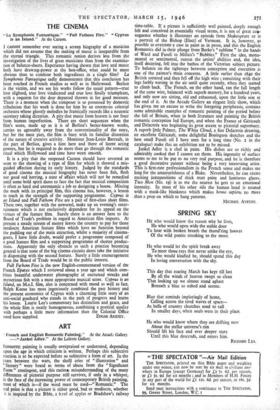ART
French and English Romantic Painting." At the Arcad: Gallery. —"Jankel Adler." At the Lefevre Gallery.
ROMANTIC painting is usually overpraised or underrated, depending upon the age in which criticism is written. Perhaps this subjective reaction is to be expected before so subjective a form of art. In the years between the wars, the shrill cries of " illustration " and " literary " were heard as terms of abuse from the " Significant Form " contingent, and this curiouic misunderstanding of the many differences of pictorial purpose still survives, if only in a whisper, in the face of the increasing power of contemporary British painting, most of which is—if the word must be used—" Romantic." The real point is that a picture is either good, bad or mediocre, whether it is inspired by the Bible, a byx1 of apples or Bradshaw's railway
time-table. If a picture is sufficiently well painted, deeply enough felt and conceived in essentially visual terms, it is not of great cos- sequence whether it illustrates an episode from Shakespeare or is a portrait of the Bishop (Elect) of Vermont. It is, however, as possible to overstate a case in paint as in prose, and this the English Romantics did in their plunge from•Burke's " sublime " in the hands of Ward and Fuseli to Millais's " Bubbles." First the idea, monu- mental or sentimental, outran the artists' abilities and, the idea, itself decaying, fell into the bathos of the Victorian subject picture. To balance on the tightrope between conception and execution is one of the painter's main concerns. A little earlier than 184o the British tottered and then fell off the high wire ; remaining with their legs feebly waving in the air until quite recently, when they started to climb back. The French, on the other hand, ran the full length of the same wire, balanced with superb mastery, for a hundred years, and only now are sitting, old and exhausted, upon the little seat at the end of it. At the Arcade Gallery an elegant little show, which has given me an excuse to write the foregoing periphrasis, contains some admirable examples of romantic painting of the period before the fall of Britain, when in both literature and painting the British romantic conception fed Europe, and when the France of Gericault and Delacroix was beginning its great ascent to pictorial supremacy. A superb little Palmer, The White Cloud, a fine Delacroix drawing, an excellent Gericault, some delightful Bonington sketches and the best small Fuseli oil I have seen for a long time (No. 2 in the catalogue) make this an exhibition not to be missed.
Jankel Adler is a chef in paint. His dishes are so richly and admirably cooked that I cannot eat them. His ingenuity of surface seems to me to be put to no very real purpose, and he is therefore a good decorative painter without being a very interesting artist. This is first-rate professionalism in the French sense and makes me long for the amateurishness of a Blake. Nevertheless, he can create exciting juxtapositions of thick matt paint and luminous glazes. Two Men (No. 19) is to me the nearest he gets to an emotional intensity. In most of his other oils the human head is treated with a mask-like blankness which makes homo sapiens no more than a prop on which to hang patterns.
MICHAEL AYRTON.


























 Previous page
Previous page